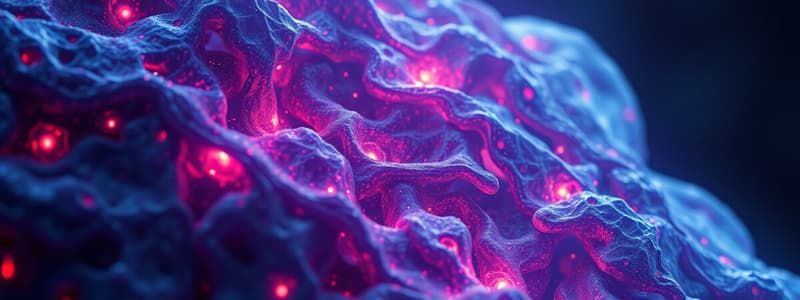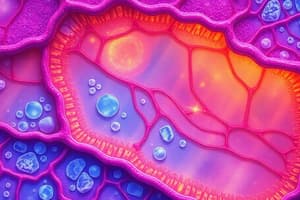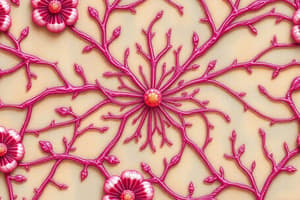Podcast
Questions and Answers
What is the primary function of epithelial tissue?
What is the primary function of epithelial tissue?
- Support
- Control
- Protection (correct)
- Movement
Which characteristic is true of epithelial cells?
Which characteristic is true of epithelial cells?
- They have low regeneration potential.
- They contain a large interstitial space.
- They are only found in the skin.
- They are polyhedral in shape. (correct)
Which of the following is NOT a major component of connective tissue?
Which of the following is NOT a major component of connective tissue?
- Ground substance
- Collagen fibers
- Elastic fibers
- Neurons (correct)
Which statement about the function of connective tissue is correct?
Which statement about the function of connective tissue is correct?
Which type of connective tissue cell is responsible for producing collagen?
Which type of connective tissue cell is responsible for producing collagen?
Which type of connective tissue is characterized by a loose weave of fibers and widely scattered cells?
Which type of connective tissue is characterized by a loose weave of fibers and widely scattered cells?
What is a primary function of connective tissue?
What is a primary function of connective tissue?
Which option describes a characteristic of dense connective tissue?
Which option describes a characteristic of dense connective tissue?
Which type of membrane is considered a connective tissue membrane?
Which type of membrane is considered a connective tissue membrane?
Which term best describes the organization of the human body into segments like the upper limb or abdomen?
Which term best describes the organization of the human body into segments like the upper limb or abdomen?
What is a characteristic of gross anatomy?
What is a characteristic of gross anatomy?
What differentiates systemic anatomy from gross anatomy?
What differentiates systemic anatomy from gross anatomy?
Which of the following is an example of a glycosaminoglycan found in ground substance?
Which of the following is an example of a glycosaminoglycan found in ground substance?
What term describes the plane that divides the body into anterior and posterior sections?
What term describes the plane that divides the body into anterior and posterior sections?
Which of the following is NOT a basic function of cells?
Which of the following is NOT a basic function of cells?
Homeostasis is best described as which of the following?
Homeostasis is best described as which of the following?
Which of the following correctly defines an organ system?
Which of the following correctly defines an organ system?
What is the role of anatomical studies in clinical practice?
What is the role of anatomical studies in clinical practice?
Which of the following levels of structural organization is the smallest?
Which of the following levels of structural organization is the smallest?
Which cell type is primarily responsible for sending and receiving signals?
Which cell type is primarily responsible for sending and receiving signals?
In the context of anatomy, what does 'flection' refer to?
In the context of anatomy, what does 'flection' refer to?
Which movement involves bending or decreasing the angle between bones or body parts?
Which movement involves bending or decreasing the angle between bones or body parts?
What is the standard reference position of the body used to describe locations of structures?
What is the standard reference position of the body used to describe locations of structures?
Which of the following movements indicates straightening or increasing the angle between bones?
Which of the following movements indicates straightening or increasing the angle between bones?
In which anatomical plane does abduction and adduction primarily occur?
In which anatomical plane does abduction and adduction primarily occur?
What type of rotation brings the anterior surface of the limb closer to the median plane?
What type of rotation brings the anterior surface of the limb closer to the median plane?
Which of the following refers to the movement of the sole of the foot toward the median plane?
Which of the following refers to the movement of the sole of the foot toward the median plane?
What term describes the action of moving a body part superiorly?
What term describes the action of moving a body part superiorly?
Which anatomical term refers to a position where a person is lying on their back?
Which anatomical term refers to a position where a person is lying on their back?
Which movement is characterized by a rotation of the forearm so that the palm faces posteriorly?
Which movement is characterized by a rotation of the forearm so that the palm faces posteriorly?
What term is used to describe the movement of a limb towards the midline in the frontal plane?
What term is used to describe the movement of a limb towards the midline in the frontal plane?
Which term describes a combination of all movements in a circular pattern?
Which term describes a combination of all movements in a circular pattern?
What anatomical term refers to the plane that divides the body into anterior and posterior sections?
What anatomical term refers to the plane that divides the body into anterior and posterior sections?
Which term refers to the action of the sole of the foot moving toward the lateral plane?
Which term refers to the action of the sole of the foot moving toward the lateral plane?
What describes the anatomical position in terms of facing direction?
What describes the anatomical position in terms of facing direction?
Flashcards are hidden until you start studying
Study Notes
Introduction to Human Anatomy
- Coronal plane divides the body into anterior (front) and posterior (back) sections.
- Understanding anatomy is crucial for clinicians to identify affected structures in diseases, during examinations, and surgeries.
Learning Outcomes
- Identify subdivisions of anatomy.
- Enumerate body regions and systems.
- Describe anatomical planes, positions, and movements.
Levels of Structural Organization
- Organ Systems: Groups of organs (e.g., digestive system) that work together.
- Basic Cell Types: Neuron, muscle, epithelial, and connective tissue cells.
- Basic Cell Functions: Include metabolism, responsiveness, movement, growth, differentiation, and reproduction.
- Homeostasis: Dynamic process maintaining internal stability despite external changes.
Tissues
-
Epithelial Tissue:
- Polyhedral cells with minimal interstitial space.
- Covers skin and lines body cavities (lungs, GI tract, urinary, reproductive systems).
- Capable of high regeneration; forms exocrine and endocrine glands.
-
Connective Tissue:
- Major components include non-cellular elements (collagen, elastin, and reticular fibers) and cellular components (blood cells, fibroblasts).
- Functions: Support, protection, transport, energy storage, and defense.
- Types:
- Loose connective tissue (areolar, blood, adipose).
- Dense connective tissue (cartilage, bone, tendons, ligaments).
Body Membranes
- Two types:
- Epithelial Membranes: Cutaneous, mucous, serous.
- Connective Tissue Membranes.
Subdivisions of Anatomy
- Gross Anatomy: Study of visible structures.
- Cross-Sectional Anatomy: Examines body sections.
- Surface Anatomy: Study of external body features.
- Microscopic Anatomy (Histology): Study of tissues.
- Developmental Anatomy (Embryology): Study of body development.
- Radiographic Anatomy: Study via imaging.
- Clinical Anatomy: Application in medical practice.
- Regional Anatomy: Study of specific body areas (e.g., limbs).
- Systemic Anatomy: Study based on body systems.
Anatomical Terms and Positions
- Anatomical Position: Erect stance with feet flat, arms at sides, palms, face, and eyes forward.
- Supine and Prone Positions: Supine - lying on back; Prone - lying on stomach.
Anatomical Planes
- Sagittal Plane: Divides body into left and right sections.
- Frontal Plane (Coronal Plane): Divides into anterior and posterior sections.
- Transverse Plane: Divides into superior and inferior sections.
- Oblique Plane: Divides at an angle.
Anatomical Movements
- Flexion: Decreases angle between bones.
- Extension: Increases angle between bones.
- Abduction: Movement away from the midline.
- Adduction: Movement towards the midline.
- Circumduction: Circular movement of a limb.
- Medial Rotation: Inward rotation towards the midline.
- Lateral Rotation: Outward rotation away from the midline.
Specific Movements
- Pronation: Forearm rotation so palm faces down.
- Supination: Forearm rotation so palm faces up.
- Inversion: Movement of foot sole towards the midline.
- Eversion: Movement of foot sole away from the midline.
- Elevation: Movement of body part superiorly.
- Depression: Movement of body part inferiorly.
Studying That Suits You
Use AI to generate personalized quizzes and flashcards to suit your learning preferences.




